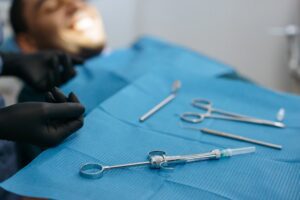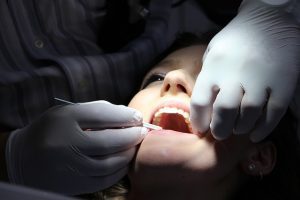Bone grafting, or the transplanting of bone tissue, is a fairly common procedure in our practice. Our oral surgeon, Dr. Puckett, is very experienced in bone and tissue grafts in the mouth and face. Dental bone grafts can help correct misaligned jawbones, allow more effective tooth replacement, and help maintain facial structure when numerous teeth have been lost.
With modern bone grafting, lost bone in your jaw can be restored naturally, with material from your own body. We think of bones as hard and unchanging, but your body is continually adding new bone cells and removing old ones. Bone grafts act as “scaffolds” for new, living bone to grow as a part of the existing bone.
When We Suggest Bone Grafts
There are five situations that call for bone grafts:
1. When gum disease has led to bone loss. When severe periodontal disease causes bone loss, teeth can become loose. To save them, the bone around them needs to be regenerated.
2. When teeth have been lost. When you lose teeth, the bone that used to surround them becomes resorbed into the body. If you lose enough bone, your facial structure can collapse. Bone grafts can provide the support necessary to prevent this. Bone grafts for lost teeth can help an oral surgeon to perform a tooth replacement, which will also help preserve the structure of your jaw.
3. When a tooth has been taken out. After a tooth is extracted, we put bone-grafting material into the socket. This not only helps maintain your facial structure and stops your mouth from shifting, but also keeps the bone healthy so an implant can be added later.
4. When you need an implant. Dental Implants require good bone volume and density, because they involve a post being embedded in the jawbone. If your jaw structure is okay but not healthy enough to properly anchor a dental implant, your oral surgeon will probably recommend a bone graft.
5. When jaw surgery is required. Sometimes, when jaw realignment is needed to relieve TMJ, sleep apnea, chewing problems, or a protruding jaw or receding chin, extra bone must be added to the jaw via mouth surgery.
Where the Bone Comes From
The material used in a graft can come from your body, a donor, or can be entirely man-made.
Today we often use processed bone that has been harvested from cows. These grafts are only the mineral content of natural bone (all the organic material has been removed), and are sterilized in a laboratory.
We have used cow bones for many years. Through a process called “guided tissue regeneration,” your body is fooled into thinking the graft is natural bone, and over time resorbs and replaces it with your own cells.
The most common synthetic material we use is a mineral called hydroxyapatite, which contains calcium phosphate, the substance that makes teeth and bones hard. We also use tricalcium phosphate (TCP) ceramics.
Grafting material comes in powder, granule, putty and gel forms. The source and type selected depend on your bone replacement requirements.
The Bone Graft Procedure
Grafting is a minor surgical procedure done in our office under local anesthesia. An incision is made in your gum to gain access to the bone, then the grafting material is added. We close the wound with stitches. Before you go home, we will share instructions for managing pain and preventing infections.
Risks
All surgical procedures involve risks such as bleeding, infection, and reactions to anesthesia. Oral surgeries specifically come with more risks for infection because of the food and drink we consume each day. Other risks of bone grafting include:
• Swelling and inflammation
• Nerve injury
• Rejection of the graft
• Reabsorption of the graft
During your surgery preparation, we will discuss these risks and how to minimize them. Smoking slows healing and the growth of bone, so if you are a smoker, we will talk about ways to stop smoking permanently.
Recovery
Recovery can vary from a few weeks to a few months, depending on the exact type of mouth surgery you had, your age and overall health. Eating a healthy diet is important for recovery. It is also good to call us before using any OTC medications, as some interfere with bone growth and healing.
Cost
The cost of bone grafting varies widely, depending on the problem being corrected, the size of the area and the volume of bone needed. Before any decisions are made, we will discuss your procedure in depth and review a written treatment plan outlining the costs. We can assist you in budgeting for the cost of treatment if it is not covered by your insurance.
To explore whether bone grafting may be a solution for your dental problem, contact Wilmington Oral Surgery at any time.










